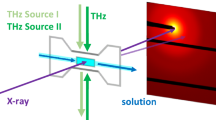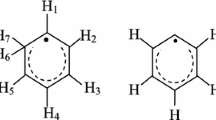Abstract
The effect of terahertz radiation on the functional activity of bovine serum albumin was studied by electron paramagnetic resonance spectroscopy using spin trapping and spin probing techniques. The use of a pH sensitive imidazoline spin trap allowed us to record the change in the binding strength of albumin with nitric oxide. The change in the intensity and width of bands in the EPR spectrum of the spin probe under terahertz irradiation was shown using a spin probe formed directly in the aqueous solution of albumin from a precursor, dihydropyrazine dioxide, which indicates a change in the number and mobility of paramagnetic centers. The observed changes were correlated with the structural characteristics of the reaction centers of bovine serum albumin, the functional groups of the amino acids of the protein.





Similar content being viewed by others
REFERENCES
Y.-S. Lee, Principles of Terahertz Science and Technology (Springer-Verlag, USA, 2009).
M. Van Exter, C. Fattinger, and D. Grischkowsky, Opt. Lett. 14, 1128 (1989).
V. I. Fedorov, D. S. Serdyukov, O. P. Cherkasova, et al., Optich. Zh. 84 (8), 9 (2017).
I. Ilina, D. S. Sitnikov, and M. B. Agranat, High Temperature 56 (5), 789 (2018).
V. I. Fedorov, A. S. Pogodin, T. D. Dubatolova, et al., Biophysics (Moscow) 46 (2), 293 (2001).
A. A. Angeluts, A. B. Gapeyev, M. N. Esaulkov, et al., Quantum Electron. 44 (3), 247 (2014).
G. J. Wilmink, B. D. Rivest, C. C. Roth, et al., Lasers Surg. Med. 44, 152 (2011).
J.-Y. Chen, J. R. Knab, J. Cerne, et al., Phys. Rev. E 72 (4), 040901 (2005).
J. Chen, J. Knab, S. Ye, et al., Appl. Phys. Lett. 90, 243901 (2007).
O. P. CHerkasova, V. I. Fedorov, E. F. Nemova, and A. S. Pogodin, Optika Spektrosk. 107 (4), 566 (2009).
B. Born, S. J. Kim, S. Ebbinghaus, et al., Faraday Discuss. 141, 161 (2009).
B. Born, H. Weinga¨rtner, E. Bru¨ndermann, et al., J. Am. Chem. Soc. 131, 3752 (2009).
E. F. Nemova, O. P. Cherkasova, and V. I. Fedorov, Proc. SPIE 7993, 799325-1 (2010).
O. P. Cherkasova, V. I. Fedorov, E. F. Nemova, et al., Proc. SPIE 6727, 672721-1 (2007).
A. Farrugia, Transfusion Med. Rev. 24 (1), 53 (2010).
A. V. Kapralova and A. S. Pogodin, Vestn. Novosibirsk. Univ., Ser. Fiz. 5 (4), 182 (2010).
V. D. Antsygin, A. A. Mamrashev, N. A. Nikolaev et al., Avtometriya 46 (3), 110 (2010).
G. G. Dultseva, G. I. Skubnevskaya, A. Ya. Tikhonov, et al., J. Phys. Chem., 100 (44), 17523 (1996).
F. N. Dultsev and G. G. Dultseva, Chem. Engineer. Sci. 1 (2), 17 (2013).
V. M. Govorun, V. E. Tretiakov, N. N. Tulyakov, et al., Int. J. Infrared Millimeter Waves 12 (12), 1469 (1991).
A. C. Pereira, M. Paulo, A. V. Araujo, et al., Braz. J. Med. Biol. Res. 44 (9), 947 (2011).
A. F. Vanin, Usp. Fiz. Nauk 170 (4), 455 (2000).
V. I. Fedorov, N. Ya. Weisman, E. F. Nemova, et al. Biophysics (Moscow) 58 (6), 1043 (2013).
ACKNOWLEDGMENTS
The authors thank the Spectroscopy and Optics Center for Collective Use of the Institute of Automation and Electrometry, Siberian Branch of the Russian Academy of Sciences, for providing the source of terahertz radiation.
Funding
The studies were carried out within the state program of the Ministry of Science and Higher Education of the Russian Federation (AAAA-A17-117030310290-5).
Author information
Authors and Affiliations
Corresponding author
Ethics declarations
Conflict of interests. The authors declare that they have no conflict of interest.
Statement on the welfare of animals. This article does not contain any studies involving animals performed by any of the authors.
Statement of compliance with standards of research involving humans as subjects. This article does not contain any studies involving humans as subjects of research.
Additional information
Translated by D. Novikova
Abbreviations: BSA, bovine serum albumin; DPDO, 1,4-dihydropyrazine dioxide; EPR, electron paramagnetic resonance; PMIO, 1,2,2,5,5-pentamethyl-3-imidazoline-3-oxide.
Rights and permissions
About this article
Cite this article
Nemova, E.F., Cherkasova, O.P., Nikolaev, N.A. et al. A Study on Molecular Mechanisms of Terahertz Radiation Interaction with Biopolymers Based on the Example of Bovine Serum Albumin. BIOPHYSICS 65, 410–415 (2020). https://doi.org/10.1134/S000635092003015X
Received:
Revised:
Accepted:
Published:
Issue Date:
DOI: https://doi.org/10.1134/S000635092003015X




